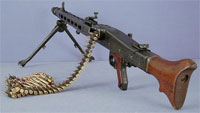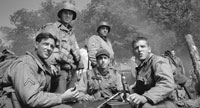MG 42 Machine Gun

Unlike the Americans, the German Army did not employ light, medium or heavy machine guns in World War II, but instead standardized on one machine gun, the Maschinengewehr 42, which was the successor to the more complicated and difficult to manufacture MG 34.
The weapon entered service in 1942 and over the next three years approximately 400,000 were manufactured by companies including Mauser Werke AG, Gustloff-Werke, Grossfuss in, Magnet and Steyr-Daimler-Puch.
The MG 42 was reliable, powerful, lightweight, easy to service, and fairly inexpensive to produce. It had few weaknesses, although its high rate of fire did cause significant vibration which could throw off a gunner's aim. The MG 42's barrel could be swapped out and replaced in 30 seconds or less.
The MG 42 was designed to operate in two modes. When used by an infantryman the MG 42 was equipped with a bipod and was considered to be in light machine gun mode. It could be configured for heavy machine gun mode by mounting it on a tripod and fitting it with long-range sights.
German units often organized themselves around the firepower that the MG 42 could provide, and almost all rifleman were tasked with carrying ammunition for it. With its extremely high rate of fire the MG 42 required a significant amount of ammunition to keep it in operation. The MG 42 was often operated by a three-man crew; a gunner, a loader and a spotter. The gunner was usually a junior NCO, as it was too valuable a weapon to be placed in the hands of anyone less experienced.
The United States Army's current M60 machine gun is based in part on the MG 42 design.
Notes
The MG42 is most clearly seen in the scenes following the attack on the German radar station and the death of Medic Wade. It is also seen during the Omaha Beach sequence. 15 MG 42s were used in the making of the movie.

